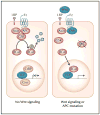Molecular Genetics of Colorectal Cancer: An Overview
- PMID: 19079560
- PMCID: PMC2597811
- DOI: 10.1007/s11888-006-0002-2
Molecular Genetics of Colorectal Cancer: An Overview
Abstract
Colorectal cancer (CRC) is a major cause of morbidity and mortality from cancers in the United States. Recent studies have revealed the paradigm in which sequential genetic changes (mutations) result in the progression from normal colonic tissues to frank carcinoma. In particular, the study of hereditary colorectal cancer and polyposis syndromes such as familial adenomatous polyposis and hereditary nonpolyposis colon cancer has contributed enormously to the understanding of the pathogenesis of CRC. Here we describe some of the common genetic pathways in CRC and the mechanisms of action for some of the key genes involved in the formation of CRC. The understanding of the genetic pathways and functions in CRC may lead to the development of novel therapeutic approaches for treating this deadly disease.
Figures


References
-
- American Cancer Society. Cancer Facts & Figures 2005. [Accessed January 31, 2006]. http://www.cancer.org/downloads/STTCAFF2005f4PWSecured.pdf.
-
- Fearon ER, Vogelstein B. A genetic model for colorectal tumorigenesis. Cell. 1990;61:759–767. - PubMed
-
- Kinzler KW, Vogelstein B. Lessons from hereditary colorectal cancer. Cell. 1996;87:159–170. - PubMed
-
- Sparks AB, Morin PJ, Vogelstein B, et al. Mutational analysis of the APC/beta-catenin/Tcf pathway in colorectal cancer. Cancer Res. 1998;58:1130–1134. - PubMed
Grants and funding
LinkOut - more resources
Full Text Sources

